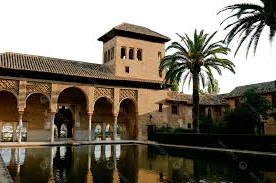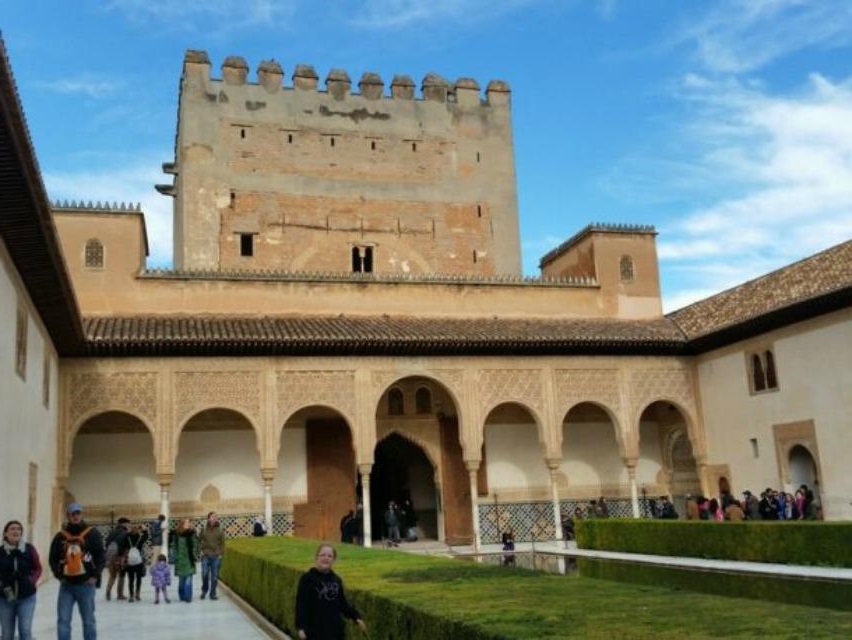A Brief History: From Nasrid Foundation to Renaissance Echoes
The Alhambra finds its origins in the Nasrid dynasty, the final Muslim rulers of Al‑Andalus, who built much of the current palace and fortress complex during the 13th and 14th centuries. indiabites.in+3Wikipedia+3madainproject.com+3 The palace was intended not merely for defense, but as the political and ceremonial heart of the Nasrid Emirate—demonstrating power, piety, and artistic sophistication. madainproject.com+1
After 1492, when the Christian Reconquista reached Granada, the Alhambra passed into Christian hands. Subsequent architects introduced Renaissance elements, most notably the Palace of Charles V. Yet the Christian additions did not erase the Moorish soul of the complex; rather, they layered new textures on the base of Nasrid craftsmanship. Werle + Wagner+2unescohunt.com+2
Over time, war, neglect, and natural disasters damaged parts of the complex, but restoration efforts from the 19th century onward—including meticulous conservation of woodwork, tile, stucco, and gardens—have helped preserve the Alhambra’s glory. Encyclopedia Britannica+2MDPI+2
Architectural Brilliance: Geometry, Decoration, and Light
What distinguishes the Alhambra is not just its scale but the refinement of its detail. The architects and artisans who built it employed principles of geometry, proportion, symmetry, and light in extraordinary ways.
Nasrid Palaces & Key Spaces
At the heart lie the Nasrid Palaces, composed of several interlinked structures, including the Mexuar, the Comares Palace, and the iconic Court of the Lions. Wikipedia+2madainproject.com+2 The Court of the Lions features a rectangular courtyard with a central marble fountain supported by twelve sculpted lions, surrounded by arcades and delicate arches. Wikipedia+1 Adjoining halls—such as the Hall of the Ambassadors and the Hall of the Two Sisters—display elaborately carved wood ceilings, muqarnas vaulting, and subtle lighting that plays across filigreed screens and archways. Werle + Wagner+2madainproject.com+2
Decorative Arts: Stucco, Tilework, Calligraphy
No corner of the Alhambra is spared from ornamentation. Stucco (yesería) is carved into arabesque (vegetal) patterns, geometric motifs, and quotations in Arabic script. These surfaces are richly textured yet balanced, never crowded. indiabites.in+3madainproject.com+3turismogranada.info+3
Tile mosaics (zellij or azulejos) cover walls and floors with vivid geometric and vegetal designs, their colors enhanced by the shifting daylight. MDPI+2madainproject.com+2 Calligraphy—poems, Quranic verses, devotional phrases—runs along friezes, balconies, and thresholds, integrating spiritual meaning with aesthetic beauty. turismogranada.info+1
Water, Gardens, and Nature
Integral to Moorish architecture is water: fountains, reflecting pools, channels, sound, and movement. Within the Alhambra, water is everywhere—rippling in courtyards, murmuring in gardens, creating reflections of architecture and sky. theworldcastle.com+2unescohunt.com+2
The Generalife Gardens, the summer retreat adjacent to the Alhambra, epitomize this blend of nature and architecture. Terraced gardens, fragrant flowers, tree‑lined paths, and cooling fountains offer respite and spiritual calm. Here, the Moorish tradition of paradise gardens takes physical form. UNESCO World Heritage Centre+1
Symbolism & Spiritual Resonance
Behind the lavish decoration lies deep symbolic meaning. Every element of the Alhambra is charged with spiritual, philosophical, or astrological reference.
-
Geometry: Islamic art often emphasizes pattern and repetition. The geometric interlacing in tilework and architectural layout expresses ideas of infinity, unity, and cosmic order. turismogranada.info+2madainproject.com+2
-
Light and shadow: The play of light through arches, screens, muqarnas, and courtyards is intentional—creating drama, tranquillity, revelations as the sun moves.
-
Water: Symbolizes purification, the presence of paradise (jannah), and refreshment—for body and spirit.
-
Words and inscriptions: Verses in Arabic, often quoting the Qur’an, or poems praising rulers, often reinforce spiritual humility, divine sovereignty, or the glory of God. turismogranada.info+1
Defensive Majesty & Strategic Design
Although much of its fame comes from its artistry and beauty, the Alhambra is also a fortress. Its defensive walls, towers, and gates—such as the Alcazaba fortress area—speak to the military needs of the time. Wikipedia+2Wikipedia+2 It was built to protect the Nasrid rulers, the inhabitants of Granada, and the political center against both external threat and internal upheaval. Wikipedia+1
The site was chosen for its defensible plateau overlooking Granada, with natural ravines and strategic elevation giving it an advantage. Encyclopedia Britannica+1
The Alhambra Today: Heritage and Visitor Experience
Today, the Alhambra along with the Generalife and the Albaicín (the old Moorish quarter of Granada) form a UNESCO World Heritage Site. UNESCO World Heritage Centre+1 Visitors come from worldwide to walk through its chambers, gardens, courts, and halls—not merely to see a building, but to feel centuries of art, faith, and power. The UNESCO listing emphasizes the Alhambra’s qualities: its architectural unity, its integration with its landscape, and its authentic preservation of Moorish tradition. UNESCO World Heritage Centre
As a living museum, the Alhambra faces challenges—restoration, protection from erosion, managing crowds, preserving delicate decoration—but current efforts are deeply rooted in historical accuracy and artisan techniques. UNESCO World Heritage Centre+2Encyclopedia Britannica+2
 Why the Alhambra Captures the Imagination
Why the Alhambra Captures the Imagination
So what is it about the Alhambra that continues to enchant writers, architects, travelers, and scholars?
-
Contrasts of scale: vast defensive walls and intimate, jewel‑box chambers.
-
Synthesis of art forms: woodwork, stucco, tile, calligraphy—all woven together into coherent whole.
-
Sensory richness: sound of running water, scent of orange blossoms, flicker of light through archways.
-
Layers of history: Moorish origin, Christian influence, modern care—stories embedded in stone, tile, ornament.
-
Spiritual ambience: not just secular power and luxury, but an expression of Islamic cosmology, mirrored in water, in light, in inscriptions.
Visiting the Alhambra: Practical Tips
For anyone planning a visit:
-
Best times: Early morning or late afternoon when light is softer and crowds thinner.
-
Must‑see areas: Nasrid Palaces (especially the Court of the Lions), Generalife Gardens, Comares, Hall of the Ambassadors.
-
Photographic moments: Reflections in water, muqarnas ceilings, marble fountains, tiled walls.
-
Respect conservation rules: many areas are fragile; some parts have entry restrictions to preserve decoration.
-
Guided tours: Very helpful for understanding symbolic meaning, hidden details, stories behind inscriptions.
Conclusion
The Alhambra is more than ferocious architecture or ornamental display—it is Moorish majesty carved into mountain, water and light, a palace where art, faith and power meet in harmony. From its architectural innovations to its spiritual depth, from its symbolic geometry to its lush gardens, the Alhambra remains a benchmark of human creativity. It invites not just sight, but reflection.
Whether you are an art lover, history buff, spiritual seeker or casual traveler, the Alhambra whispers centuries of stories. To walk into its courtyards is to step into a living poem—a work of art that pulses with the legacy of Moorish Spain, preserved across time.


You must be logged in to post a comment.